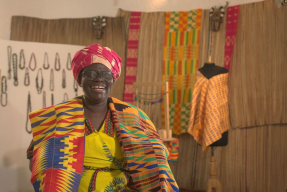
by Zev Lowe, KF8 Indonesia
Over the course of my Kiva fellowship with DINARI Foundation – Bali, I have had the chance to meet clients who engage in various kinds of business activities. I’ve met small shopkeepers who shrug matter-of-factly when they tell me that their main source of revenues come from cigarettes, I’ve met pig farmers who have been able to rattle off stud fees, gestation periods and prices per kilogramme over the last few months, and I’ve met incredibly hardworking people who sort through trash in order to collect recyclables, who are often shunned because of the way they smell.
I enjoy listening to all their stories. But my favourite clients to visit, by far, have been artisans, because it’s so much fun watching them at work. I’d like to share two videos I took of clients who were kind enough to demonstrate their craft on video.
First, we have Heri Priyanto, originally from Java, who takes us through the process, from start to finish, of making a leather wristband (video is 2m 33 seconds long). He can braid one of these every minute. When I asked him how many he can make a day, he laughed, and reminded me to take into account his need to sleep, shower and eat.
'Heri is unusual as a DINARI client because he doesn’t actually need the small loan he took out (for 1m IDR, or about USD 100). He is just hoping to build up his credit history to the point where he can borrow enough to buy one tonne of leather scraps (20m IDR, or about USD 2000). He is clearly a thoughtful and resourceful guy, and I wished him luck in achieving his dream.
The second video (1m 5 seconds long) is of Ni Putu Dian, who demonstrates how to make “Banten” or traditional Balinese Hindu offerings. The containers for the offerings are made from coconut fronds, and this is what you’ll see in the video. Later, she will place flowers and shredded lemongrass leaves in the container to complete the offering. Sometimes food items are added, like a piece of fried banana or a prawn fritter (krupuk). This craft runs in her family, and she started learning it when she was just 10 years old.
'Offerings are a large part of Balinese Hindu culture. Simple offerings are placed outside the home twice a day – once in the morning, and once at sunset. A stick of incense is usually lit on top of it, and a prayer is also said. More elaborate offerings are made for special occasions. Every month, the Balinese calendar has 5 minor festivals, all of which require offerings. Ibu Dian is even busier during major festivals, which happen twice a year – first, the celebration of the victory of Dharma over Adharma, which is commemorated with the Galungan festival and then 10 days later with the Kuningan festival, and second the occasion that celebrates Dewi Saraswati, who brings books and knowledge to humankind.
Zev Lowe is enjoying his last week as a Kiva Fellow in Bali. He is tweeting his heart out as @zevlowe. If you enjoyed these videos, please consider signing up for a Kiva Alert which will inform you when a DINARI client is requesting funds. You can also join the DINARI Foundation lending team here.
/>













